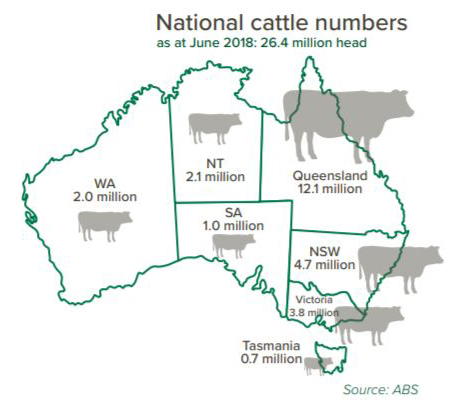Master the Art of Cooking With Yard Fed Meat
In the realm of cooking knowledge, understanding the art of food preparation with grass-fed meat holds a distinguished setting. From the tender appearance to the robust flavor profile, grass-fed meat provides a canvas for cooking creativity.
Benefits of Grass-Fed Meat

When choosing grass-fed meat, consumers can benefit from its higher levels of omega-3 fatty acids and antioxidants contrasted to traditionally raised meat. Constance Cattle. Omega-3 fats are important nutrients that sustain mind health, reduce inflammation, and advertise heart wellness. Grass-fed meat is recognized to have up to 5 times more omega-3 fats than grain-fed meat, making it a healthier option for those seeking to boost their intake of these valuable fats
Along with omega-3 fats, grass-fed meat is likewise richer in anti-oxidants such as vitamins E and C, in addition to beta-carotene. Antioxidants play a vital function in safeguarding cells from damage triggered by totally free radicals, which can contribute to numerous persistent illness and speed up aging. By choosing grass-fed meat, customers can not only delight in a more nutrient-dense and savory protein source yet also support their general health and health.
Integrating grass-fed meat into your diet regimen can be a basic yet efficient way to boost your nutritional intake and profit of omega-3 fatty acids and antioxidants that are normally abundant in this kind of meat.
Finest Food Preparation Techniques
Using suitable food preparation methods is important to protect the nutrient account and improve the flavor of grass-fed meat. When cooking grass-fed meat, it is necessary to keep in mind that it is leaner than conventionally elevated meat, making it extra susceptible to drying if overcooked. To make certain a juicy and tasty end result, consider cooking grass-fed meat at a little lower temperature levels than you would with grain-fed meat.
Cooking is a popular technique for food preparation grass-fed meat as it permits excess fat to drip away, protecting against flare-ups that can create charring. An additional fantastic cooking technique for grass-fed meat is pan-searing.
Slow cooking methods such as braising or cooking are additionally exceptional alternatives for tougher cuts of grass-fed meat, as they help break down the muscle mass fibers and soften the meat. Whichever food preparation approach you choose, remember to allow grass-fed meat rest after cooking to permit the juices to rearrange, ensuring a moist and tender final meal.
Flavor Pairings and Seasonings
To boost the all-natural tastes of grass-fed meat, tactical flavor pairings and seasonings play a crucial duty in boosting the general dining experience. Grass-fed meat has an abundant, unique taste that can be complemented and boosted by very carefully selected ingredients.
Along with natural herbs, spices such as black pepper, garlic, and smoked paprika can further boost the taste profile of grass-fed meat meals. These spices give a balance of heat, sweet taste, and smokiness that can improve the overall eating experience. When seasoning grass-fed meat, it is vital to use high-quality salt, like sea salt or Himalayan salt, to draw out the meat's flavors without including unnecessary chemicals or ingredients.
Storage and Handling Tips
Appropriate storage and taking care of practices are crucial for keeping the quality and quality of grass-fed meat. When storing grass-fed meat, it is crucial to keep it cooled at temperatures listed below 40 ° F(4 ° C) to avoid microbial development and spoilage. To prolong the meat's service life, take into consideration wrapping it securely in parchment paper or butcher paper prior to putting it in an impermeable container or sealed plastic bag - Constance Cattle. Prevent saving grass-fed meat near strong-smelling foods as it can absorb smells conveniently.
When dealing with grass-fed meat, it is necessary to practice great health to stop cross-contamination. Wash your hands completely prior to and after handling the meat, and make sure that all tools and surface areas that enter contact with the meat are cleaned check my reference up and disinfected properly. Additionally, use separate cutting boards for meat and veggies to prevent microbial transfer.

Leading Grass-Fed Meat Recipes
When thinking about the very best ways to relish the quality and quality of grass-fed meat, discovering first-class dishes can elevate your culinary experience. Grass-fed meat's abundant learn the facts here now taste and leaner account provide themselves well to a selection of dishes that highlight the natural benefits of the meat. One leading recipe to try is a traditional Grilled Grass-Fed Ribeye Steak skilled with simple components like salt, pepper, and a touch of garlic for a durable taste. For a reassuring dish, a Slow Cooked Grass-Fed Beef Stew with root veggies and great smelling natural herbs is a hearty choice that highlights the meat's tenderness.
If you remain in the state of mind for something lighter, a Grilled Grass-Fed Hamburger offered with fresh garnishes and a side of sweet potato fries is a delicious option. Furthermore, a Herb-Crusted Grass-Fed Crown roast baked to perfection with a collection of natural herbs and breadcrumbs is a show-stopping recipe for unique celebrations. These leading grass-fed meat dishes showcase the adaptability and superior high quality of grass-fed meat, enabling you to enjoy its remarkable taste in different culinary creations.

Final Thought
In verdict, mastering the art of cooking with grass-fed meat uses countless advantages, including improved nutritional value and remarkable taste. By utilizing the best cooking techniques, trying out taste pairings and spices, and adhering to correct storage and dealing with ideas, you can produce scrumptious and nourishing recipes. Attempt out some leading grass-fed meat dishes to boost your cooking abilities and appreciate the complete potential of this high-quality component.
When cooking grass-fed meat, it find out here is important to bear in mind that it is leaner than conventionally elevated meat, making it much more vulnerable to drying out if overcooked. To guarantee a juicy and flavorful result, consider cooking grass-fed meat at somewhat lower temperature levels than you would with grain-fed meat.
When seasoning grass-fed meat, it is vital to use top quality salt, like sea salt or Himalayan salt, to bring out the meat's flavors without including unneeded chemicals or ingredients.
Grass-fed meat's abundant taste and leaner account offer themselves well to a range of dishes that highlight the natural benefits of the meat. These leading grass-fed meat recipes display the convenience and superior high quality of grass-fed meat, enabling you to enjoy its superior preference in various cooking creations.
 Anna Chlumsky Then & Now!
Anna Chlumsky Then & Now! Tatyana Ali Then & Now!
Tatyana Ali Then & Now! Marcus Jordan Then & Now!
Marcus Jordan Then & Now! Robbie Rist Then & Now!
Robbie Rist Then & Now! Atticus Shaffer Then & Now!
Atticus Shaffer Then & Now!